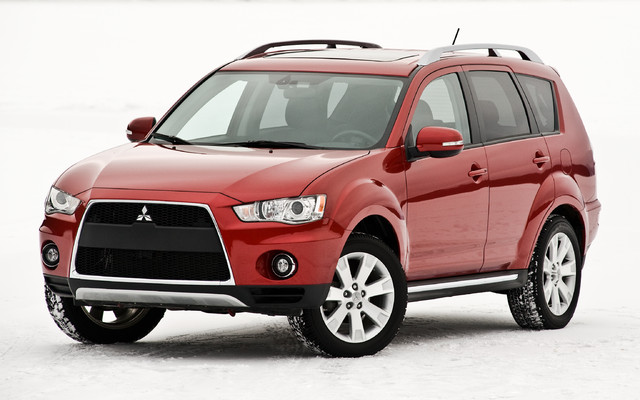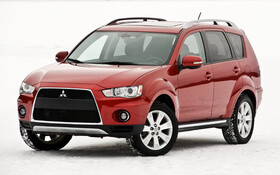An Incredibly Capable Commuter: The 2010 Mistubishi Outlander

| Strong points |
|
|---|---|
| Weak points |
|
When it comes to people haulers, the options are literally endless. Between sedans, minivans, and sports utility vehicles, there’s no shortage of sizes, capacities, capabilities, and shapes to fit nearly every need, which can make the already-complex car buying experience even more complicated. With such massive brands as Chevy, Toyota, Ford, Honda, and Chrysler all vying for your attention, it’s easy to forget the often-forgotten and diminutive entry from Mistubishi: the Outlander. But, while one could wax on poetically about the compelling new aesthetics of the 2010 Outlander’s nose job, the reality is this: The Car Guide is not available in Braille, so I’ll let you be the judge. Besides, the most compelling reason to take a 2010 Outlander for a spin is what Mitsubishi’s engineers have stuffed underneath that pretty new nose, anyway.
Having first encountered the Outlander on a road test a few years ago, I came away impressed with the crossovers exuberance and verve. Although saddled with a CVT and a relatively agrarian powerplant, the Outlander performed exceedingly well, punching well above its weight on dry tarmac and proving absolutely hilarious in the snow. Shovelling every last ounce of effort to all four wheels via a lockable centre differential, it was a veritable donutter’s delight when the white stuff started to fall in the local grocer’s parking lot. And of course, with a Christmas dinners-worth of foodstuffs safely stowed away in its cavernous rear compartment, it made quick work of even Vancouver’s poorly-ploughed and unseasoned carriageways.
But this year, that’s all gone... on the top level XLS model, at least. Replacing the now-familiar 2WD/4WD/Lock selector traditionally found between the front seats is a new knob, labelled “Tarmac/Snow/Lock.” Controlling the brand’s stupendous Super All-Wheel Control system, the knob alters the drivetrain’s power delivery both fore and aft and left to right. In Tarmac mode, the system shuttles all of the available power to the front end under normal driving circumstances; only diverting torque to the rear as needed. Not surprisingly, Snow mode is more liberal with the power, with a modicum of power consistently being deployed to the rear axle to pre-empt slides. Finally, the Lock position provides drivers with a 50:50 static torque split augmented by an electronically coupled rear differential that locks up to provide even more traction. Out front, Mitsubishi’s Active Front Differential diverts power across the differential from left to right to counteract the nose-heavy crossover’s propensity for understeer; using yaw sensors to detect an understeering condition and correcting it by sending more power to the outside front wheel. Doing this in all modes, the system worked fantastically on Vancouver’s wet roads, endowing the refreshed Outlander with a very sure-footed quality few crossovers could match. However, still wearing decidedly out-of-season Toyo snow tires rolling over saturated asphalt, the 3.0L, 230 horsepower V6 quickly overwhelmed the front end when left in Tarmac mode, requiring much delicacy to extract as much speed as possible out of each corner exit. Twisting the S-AWC knob to Lock addressed the problem, and allowed the V6 to put the power down to a much greater degree. It’s also worth noting that XLS models also benefit from the addition of a six speed Sportronic paddle-shifted automatic transmission that, while falling short of the dual-clutch SST gearbox found in the Evolution and Lancer Ralliart, does an admirable job of changing gears smoothly, and on command. Downshifts were as quick as one could ever want in a vehicle of this ilk, while upshifts where all but unnoticeable during normal driving. Interestingly, the transmission also has the ability to automatically slip into neutral while stopped, decreasing both emissions and fuel consumption by reducing the engine’s load. Only perceptible via the slight rise in engine speed at red lights, it works in concert with the XLS model’s Hill Start Assist system which prevents the automatic transmission-equipped truck from rolling backwards on steep hills before it has a chance to automatically engage drive.
While this exemplary performance can be attributed to the incredibly complex technology that underpins this top-level XLS model, the Outlander’s interior is a treat that spans the entire model range. While previous Mitsubishi’s have left me unimpressed by acreages of hard black plastic and downright boring designs, this new Outlander was something of a revelation from the Japanese giant. Looking like a smoother, classier version of the interior found encased in the Lancer’s unibody, the interior boasts nicely stitched leather placed strategically throughout in areas I’d expected to find the familiar black pebble-finished plastic. Door tops, glove boxes and the dashboard are all given the soft-touch treatment, and it’s surprising how much just a few swatches of leather change the car’s appeal. Likewise, tasteful chrome rings surround the climate controls that live below a decidedly upmarket touch-screen navigation system that gives you everything from your location to the current barometric pressure. As a well-organized people-hauler, it’s endowed with plenty of storage spaces too, from the dual gloveboxes to the plethora of cupholders that abound throughout. Out back, a dual-folding tailgate makes loading easy, and a huge loadspace allows the Outlander to swallow most loads. As always, there’s a tiny rear bench that makes it (technically) a seven seater, but it’s all but useless and best folded away. The second row isn’t the most spacious, but does feature fore and aft adjustment and reclining seatbacks. Also, those with kids will appreciate the rear seat entertainment system.
Overall, the Outlander rolls into 2010 as a much more worthy competitor to the various other crossovers on the market today. Sure, the updated looks do wonders for it, but don’t let the pretty face fool you: this is easily one of the most capable crossovers on the market today. While it won’t be found trolling any rock-strewn backcountry trails, it’s more than ready to tackle nearly any inclement condition you’re liable to find in Canada thanks to the amazing S-AWC system, and do it with aplomb. And should you find yourself cruising down a pleasantly entertaining country road on one of those seemingly rare dry days, it’s got more than enough performance potential to keep you entertained.











